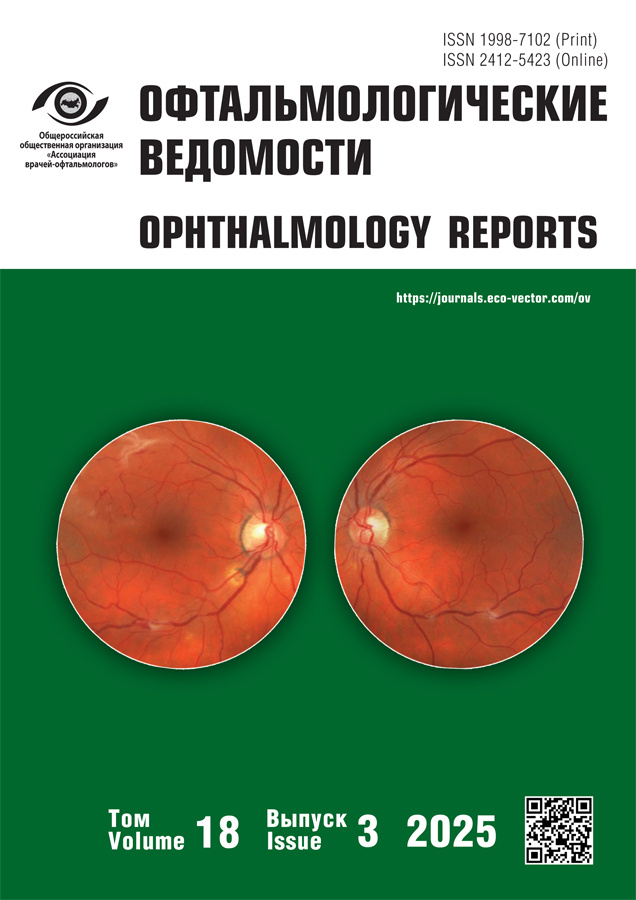MEK retinopathy: a case report
- Authors: Kalyuzhnaya A.P.1, Shakhnazarova A.A.1, Pokrovskii A.S.1
-
Affiliations:
- Diagnostic center No. 7 (ophthalmological) for adults and children, Saint Petersburg
- Issue: Vol 18, No 3 (2025)
- Pages: 65-73
- Section: Case reports
- Submitted: 16.10.2024
- Accepted: 08.07.2025
- Published: 30.09.2025
- URL: https://journals.eco-vector.com/ov/article/view/637131
- DOI: https://doi.org/10.17816/OV637131
- EDN: https://elibrary.ru/KADJXY
- ID: 637131
Cite item
Abstract
The problem of adverse side effects affecting various organs and systems in patients receiving molecular targeted therapy for oncological diseases remains relevant. One group of such drugs are inhibitors of the MEK signaling pathway. These antineoplastic agents inhibit the mitogen-activated protein kinases MEK1 and/or MEK2 and are used, among other indications, in the treatment of cutaneous melanoma. In ophthalmology, ocular toxicity associated with MEK inhibitors has been defined as MEK retinopathy—a characteristic binocular toxic retinal lesion with multifocal foci of neuroepithelial retinal detachment resembling mercury droplets, which reduces visual acuity and often resolves spontaneously or upon discontinuation of targeted therapy. This article presents a clinical case of toxic retinopathy in a female patient receiving targeted therapy with trametinib and dabrafenib for the treatment of cutaneous melanoma. The clinical manifestations and diagnostic criteria of MEK retinopathy are described, differential diagnosis with central serous chorioretinopathy is provided, and the results of empirical therapy for this condition are presented, along with insights into its course and response to different treatment methods.
Keywords
Full Text
About the authors
Alina P. Kalyuzhnaya
Diagnostic center No. 7 (ophthalmological) for adults and children, Saint Petersburg
Author for correspondence.
Email: apkalyu@mail.ru
ORCID iD: 0009-0006-9969-7216
MD
Russian Federation, Saint PetersburgAida A. Shakhnazarova
Diagnostic center No. 7 (ophthalmological) for adults and children, Saint Petersburg
Email: aida66@bk.ru
ORCID iD: 0000-0002-3053-5538
MD, Cand. Sci. (Medicine)
Russian Federation, Saint PetersburgAndrei S. Pokrovskii
Diagnostic center No. 7 (ophthalmological) for adults and children, Saint Petersburg
Email: pokrovas@gmail.com
ORCID iD: 0009-0004-6916-270X
MD
Russian Federation, Saint PetersburgReferences
- Stjepanovic N, Velazquez-Martin JP, Bedard PL. Ocular toxicities of MEK inhibitors and other targeted therapies. Ann Oncol. 2016;27(6):998–1005. doi: 10.1093/annonc/mdw100
- Duncan KE, Chang LY, Patronas M. MEK inhibitors: a new class of chemotherapeutic agents with ocular toxicity. Eye (Lond). 2015;29(8):1003–1012. doi: 10.1038/eye.2015.82
- Yanagihara RT, Tom ES, Seitzman GD, Saraf SS. A case of bilateral multifocal choroiditis associated with BRAF/MEK inhibitor use for metastatic cutaneous melanoma. Ocul Immunol Inflamm. 2022;30(7–8):2005–2009. doi: 10.1080/09273948.2021.1928714
- Han J, Chen J, Zhou H, et al. Ocular toxicities of MEK inhibitors in patients with cancer: A systematic review and meta-analysis. Oncology (Williston Park). 2023;37(3):130–141. doi: 10.46883/2023.25920987
- Vladimirova LYu. Usage of MEK inhibitors in oncology: results and perspectives. Achievements of modern natural science. 2015;(3):18–30. EDN: UDZVVJ
- Urner-Bloch U, Urner M, Stieger P, et al. Transient MEK inhibitor-associated retinopathy in metastatic melanoma. Ann Oncol. 2014;25(7):1437–1441. doi: 10.1093/annonc/mdu169
- Maubon L, Hirji N, Petrarca R, Ursell P. MEK inhibitors: a new class of chemotherapeutic agents with ocular toxicity. Eye (Lond). 2016;30(2):330. doi: 10.1038/eye.2015.243
- Tyagi P, Santiago C. New features in MEK retinopathy. BMC Ophthalmol. 2018;18(S1):221. doi: 10.1186/s12886-018-0861-8
- Francis JH, Habib LA, Abramson DH, et al. Clinical and morphologic characteristics of MEK inhibitor-associated retinopathy: Differences from central serous chorioretinopathy. Ophthalmology. 2017;124(12):1788–1798. doi: 10.1016/j.ophtha.2017.05.038
- Fasolino G, Awada G, Moschetta L, et al. Assessment of retinal pigment epithelium alterations and chorioretinal vascular network analyses in patients under treatment with BRAF/MEK inhibitor for different malignancies: A pilot study. J Clin Med. 2023;12(3):1214. doi: 10.3390/jcm12031214
- van Dijk EHC, Duits DEM, Versluis M, et al. Loss of MAPK pathway activation in post-mitotic retinal cells as mechanism in MEK inhibition-related retinopathy in cancer patients. Medicine (Baltimore). 2016;95(18):e3457. doi: 10.1097/MD.0000000000003457
- Booth AEC, Hopkins AM, Rowland A, et al. Risk factors for MEK-associated retinopathy in patients with advanced melanoma treated with combination BRAF and MEK inhibitor therapy. Ther Adv Med Oncol. 2020;12:1758835920944359. doi: 10.1177/1758835920944359
- Pandya BU, Grinton M, Mandelcorn ED, Felfeli T. Retinal optical coherence tomography imaging biomarkers: A review of the literature. Retina. 2024;44(3):369–380. doi: 10.1097/IAE.0000000000003974
- Chancellor JR, Kilgore DA, Sallam AB, et al. A Case of non-resolving MEK inhibitor-associated retinopathy. Case Rep Ophthalmol. 2019;10(3):334–338. doi: 10.1159/000503414
- Groselli S, Heinrich D, Lohmann CP, Maier M. MEK inhibitor-associated retinopathy under binimetinib treatment for cutaneous malignant melanoma. Der Ophthalmologe. 2021;118(2):169–174. doi: 10.1007/s00347-020-01089-3
- Lindboe JB, Ahmed HJ, Christakopoulos CE. Protein kinase inhibitors can induce retinopathy. Ugeskr Laeger. 2020;182(32):V05200303. PMID: 32800052
- Murata C, Murakami Y, Fukui T, et al. Serous retinal detachment without leakage on fluorescein/indocyanine angiography in MEK inhibitor-associated retinopathy. Case Rep Ophthalmol. 2022;13(2):542–549. doi: 10.1159/000524558
- Rocha Cabrera P, Quijada Fumero E, Losada Castillo MJ, et al. MEK retinopathy. Clinical case reports. Arch Soc Esp Oftalmol (Engl Ed). 2018;93(1):42–46. doi: 10.1016/j.oftal.2017.03.005
Supplementary files



















